BRC-20: Ordinals Protocol Evolution
Abstract
php Xiaobian Youzi will take you to understand BRC-20: the evolution of the Ordinals protocol. As an emerging blockchain protocol, the Ordinals protocol is of great significance in the field of decentralized finance. This protocol provides a more efficient and secure transaction method by introducing an ordinal mechanism. This article will introduce in detail the working principle and advantages of the Ordinals protocol, as well as its potential and prospects in practical applications. Let’s explore the evolution of the Ordinals protocol together!
The Ordinals protocol gives Satoshi as the smallest unit of BTC a higher transaction and collection value, bringing new opportunities to the Bitcoin ecosystem. As the Ordinals NFT market continues to grow, related infrastructure has become critical. This opens up a new track for the further development of the Bitcoin ecosystem.
The attempt to standardize the BRC-20 token has triggered a new wealth effect, and more than 18,279 BRC-20 projects have been minted on the chain. The trading market expanded rapidly, with Unisat becoming the leader, accounting for more than 50% of the trading volume.
Although BRC-20 still has some flaws, it also brings some opportunities for the future development of the BTC ecosystem. The BTC ecosystem is in its early stages and requires continuous efforts from developers and the community to fix the standard design and establish sound infrastructure to further its development. Such efforts will provide more possibilities for the development of BRC-20 tokens.
The crypto market has always been full of hot topics. Recently, BRC-20 has become the focus of much attention, gradually surpassing Arbitrum’s currency issuance and airdrop effects. BRC-20 is an experimental Bitcoin fungible token standard proposed by domo@domodata based on the Ordinals protocol. The Ordinals protocol opens a new chapter for the BTC ecosystem and decentralized development. Since its inception, BTC has always taken decentralization and free trading as its core values, and is the only cryptocurrency with commodity attributes recognized by the U.S. Securities and Exchange Commission (SEC). Although the BTC network does not have Turing completeness, there have always been developers committed to developing the BTC ecosystem and building an ecological empire similar to Ethereum. For example, the BTC second-layer network project and the Web5 network proposed by Jack Dorsey both hope to build a more powerful decentralized ecological project based on BTC.
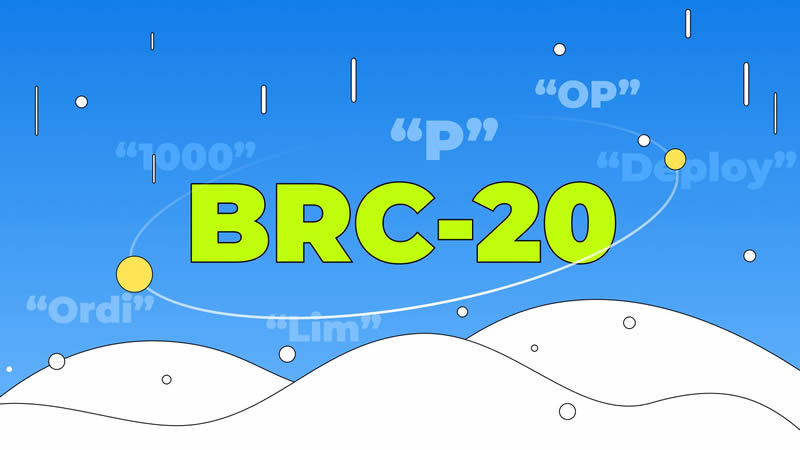
1. Ordinals Protocol: The Renaissance of BTC
Since December 14, 2022, Casey Rodarmor created the Ordinals Protocol, as of May 14 , more than 6.41 million NFTs or Tokens have been minted, opening up new opportunities for the Bitcoin ecosystem. BTC NFT is defined based on Satoshi (Satoshi), the smallest unit of measurement on the BTC network. Through the Ordinals protocol, each satoshi is given a unique identity, including number and annotation, making the originally homogeneous satoshi possess unique "NFT" characteristics. This protocol adds higher transaction value and collectible value to satoshis.
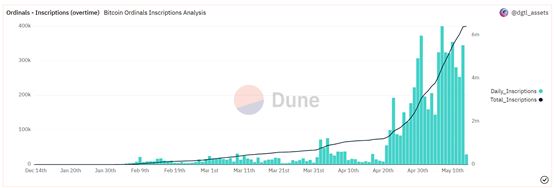
Figure 1. Ordinals-Inscriptions (overtime) (Source: dune, @dgtl_assets)
The BTC NFT minted based on the Ordinals protocol has the same relationship with the ETH NFT essential difference. Users can inscribe information on the chain, including text/pictures/audio/video, but the storage space of each block is only 4MB, which is the upper limit of Bitcoin inscription.
(1) ETH’s NFT uses smart contracts to issue and trade based on the ERC-721 or ERC-1155 standard. The only information stored on the chain is the Token ID composed of integers. This string of numbers will be mapped to the URL to retrieve the metadata (name, description, image address) about the NFT. NFT Metadata is usually stored in IPFS or centralized servers.
(2) The information in BTC NFT is completely on-chain and does not require off-chain storage of Metadata. An NFT includes a number, that is, the mining sequence starts from 0, ensuring the uniqueness of each Satoshi. Precisely because NFT is truly stored on the chain, the information contained in NFT has a size limit and cannot be modified. This is also the reason why BTC enthusiasts are so popular.
More and more blue-chip NFT project parties have also joined the BTC NFT ecosystem and achieved success. Yuga Labs’ “Twelvefold” successfully bid for a maximum of 7.115 BTC. According to a Galaxy research report, the Ordinals NFT market will reach $4.5 billion by 2025, and the market infrastructure for Ordinals NFT will be complete by the second quarter of 2023. Developers will also continue to explore new decentralized software or Bitcoin scaling technologies.
2. BRC-20: Ordinals Protocol Evolution
On March 9, the BRC-20 protocol was informally proposed by founder domo, which triggered a FOMO effect. According to ordspace.org, as of 5 As of March 14, there were more than 18,279 BRC-20 token projects, with a total market value exceeding US$500 million. Currently, the BRC-20 protocol-related transaction volume on the BTC network has exceeded the non-Ordinals protocol transaction volume. On May 7 and May 14, the BRC-20 protocol transaction volume once accounted for more than 65%, and market sentiment seems to be continuing.
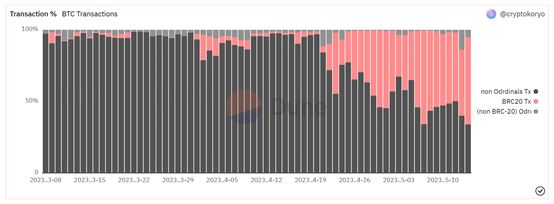
Figure 2. Proportion of BTC network transaction volume categories (Source: dune, @cryptokoryo)
The BRC-20 protocol is a technology that uses the Ordinals protocol to create and trade fungible tokens (FT) on the Bitcoin blockchain. It uses JSON data token contract information, including the name of the token, Symbol, total amount, decimal places, etc. The name "BRC-20" is a play on Ethereum's ERC-20 token standard, but BRC-20 tokens cannot interact with smart contracts and cannot perform any automated operations.
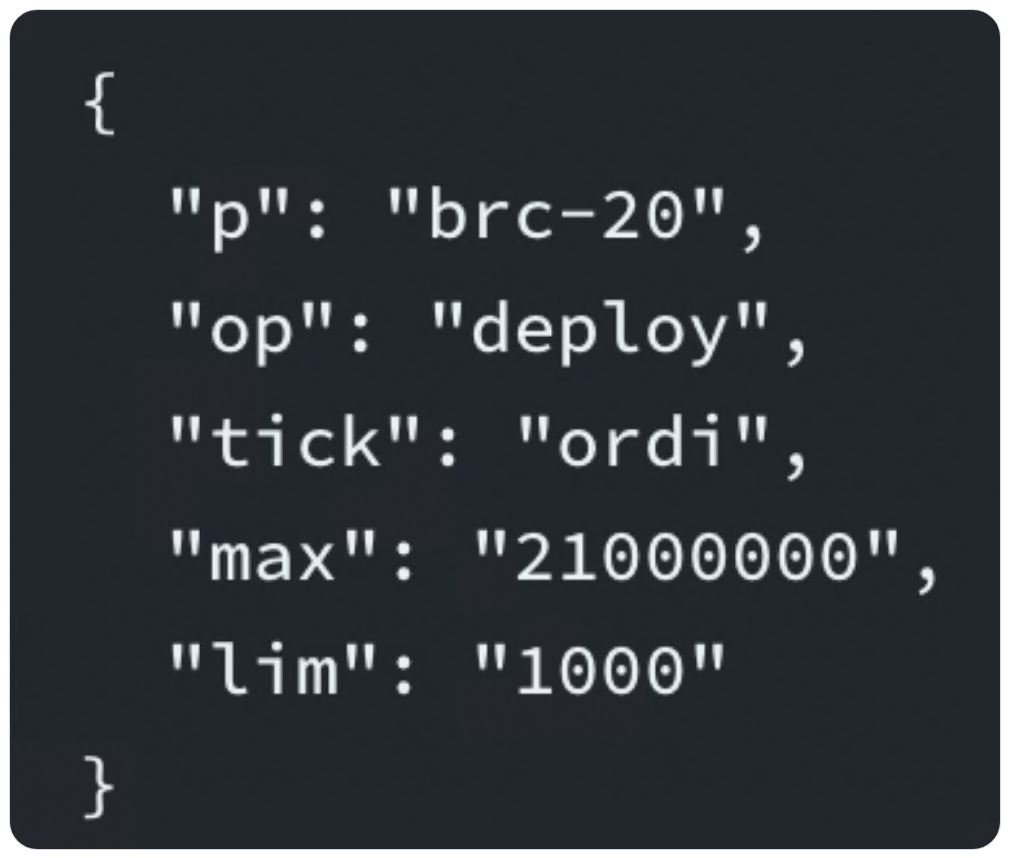
Figure 3. BRC-20 ordi deployment code (Source: twitter, @domodata)
2.1 The price miracle of Ordi tokens
Ordi is the first token issued under the BRC-20 standard with a minting limit of 1,000 tokens and a total of 21,000,000 tokens. Ordinal wallets such as Unisat quickly deployed tools for the BRC-20 standard and in less than 18 hours all 21,000,000 ordi tokens were minted. The price of Ordi also rose from US$0.1 to US$29.04 in just three weeks, achieving a hundredfold increase.
2.2 Rapid expansion of Ordinals trading market
BRC-20 Token mechanism has certain complexity and requires additional steps for storage and trading. Specifically, users need to run a full node when minting Ordinals; in addition, there is no on-chain automatic market maker on Bitcoin, and secure secondary market transactions are required. User demand and potential huge fee income have sharply accelerated the emergence of the Ordinals trading market, and even ushered in fierce competition. These infrastructure and auxiliary tools mainly serve Ordinals NFT, BRC-20 tokens and BTC domain names.
Ordinals went through a two-month hibernation period after its birth. During this period, Magic Eden recovered from the trauma of Solana and moved to the BTC NFT trading market, winning the first place in trading volume. With the subsequent emergence of BRC-20, Unisat became a dark horse in the trading market. At present, Unisat has become the number one in terms of transaction volume, with a market share of more than 50%. The creation of these tools and trading markets facilitated the multiplication of even more BRC-20 tokens, resulting in more than 30,000 ordinal inscriptions being minted in a single day.
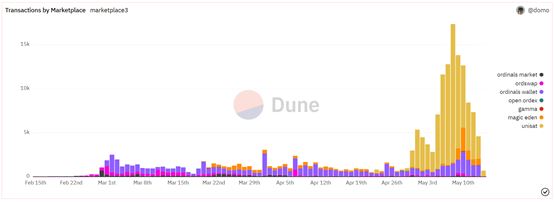
Figure 4. Comparison of the number of transactions in the BTC trading market (Source: dune, @domo)
3. Carnival boosted by multiple parties
BRC-20 tokens have greater room for speculation than BTC NFTs. From the perspectives of retail investors, exchanges, developers, and miners, this is a carnival of your own free will.
(1) Victory for BTC miners
The minting and trading of BRC-20 has brought unprecedented pressure to the BTC network. The minting and trading of a series of tokens such as BRC-20 has significantly increased BTC transaction fees. According to glassnode data, the number of transactions on the BTC chain reached 680,000 and 670,000 respectively on May 1 and May 10. On May 7, the Bitcoin network handling fee was 403.91 BTC. Just a month ago, the single-day Bitcoin network handling fee was only 21.89 BTC, an increase of nearly 18 times. As a result, Bitcoin transaction rates have reached their highest levels in the past 6 years. High handling fees and block rewards create amazing profits for miners.
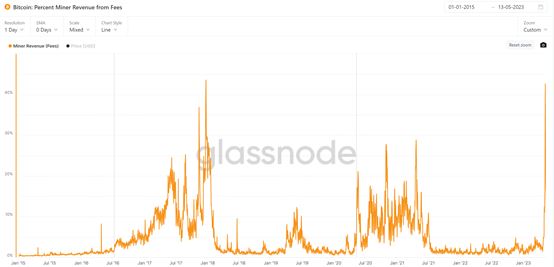
Figure 5. Proportion of Bitcoin miner fee income (source: glassnode)
(2) Joining of leading ecology and institutions
Blue-chip Ethereum NFT projects such as Yuga Labs, Crypto Punks, and BAYC have all joined the Bitcoin ecosystem and issued NFTs. NFT markets such as Magic Eden and many leading exchanges are also supporting the Ordinals ecosystem. For exchanges, they can have more opportunities for assets under management and fee income. In order to enter the BTC ecosystem early and establish relationships with the community and developers, many exchanges are more willing to be the first to take advantage than investment institutions.
(3) Boost from the BSV community
According to observations, a large number of current BRC-20 ecological applications come from the original BSV community developers, including the BRC20 wallet Unisat, which was behind the previous BSV ecosystem. The Chinese development team has developed Sensible Contract, a smart contract solution on BSV. BSV community members once again gained wealth on the BRC-20 track. The popularity of BRC-20 also provides development opportunities for developers focusing on POW chains.
4. Risks and Opportunities
The current development of BRC-20 tokens is still in its early stages, with strong meme attributes and innovative concepts, and no actual use scenarios. Moreover, the BRC-20 standard is not as comprehensive and strict as the ERC token standard, and it is not considered a standard for the fungibility of Bitcoin and ordinal numbers. As founder Domo said, this is just an experiment, and the Bitcoin community is encouraged to tinker with the standard design and optimization until there is a general consensus on best practice performance. After that, ORC-20 and BRC-721 token standard protocols appeared one after another. These token standards offer improvements in scalability, adaptability, and security.
BRC-20 may be an interesting social experiment, but it cannot be ignored that it has many flaws: (1) The ecological infrastructure of the BRC-20 token is almost zero, and the tokens are mostly meme attributes and have no use value. ; (2) The BTC ecosystem does not provide a liquid exchange and cannot guarantee the security of token transactions; (3) Since BRC-20 introduces a more complex mechanism for managing assets, additional tools or platforms are required, which results in Security is tied to the platform and is vulnerable to malicious attacks, which goes against the decentralization of BTC; (4) Regulatory risk, BTC is more like a commodity, but BRC-20 tokens may promote an unregistered one on the Bitcoin blockchain securities market.
In addition, the FOMO sentiment caused by the BRC-20 token caused serious congestion on the Bitcoin network. On May 8, there was a rare phenomenon of no block being produced for an hour. At the same time, when Bitcoin fee income continues to exceed the block reward, it may cause time-bandit attacks (Time-Bandit Attacks), and miners will choose to process transactions with higher fees and ignore transactions with lower fees. There are currently more than 300,000 unconfirmed transactions on the BTC network. Many BTC supporters are dissatisfied with the ecology of Ordinals or BRC-20, and believe that this is an attack and harm to the BTC network.
4.1 The future ecological development of BTC
Any new attempt will cause controversy and bring new thinking. We can see more possibilities for the BTC narrative through BRC-20, setting the stage for the next Get ready for the Wave Wealth Code. As more and more developers pay attention to the BTC ecological track, solutions to the on-chain congestion problem continue to emerge, and I believe that the BTC ecosystem will gradually prosper.
(1) Better token standards and smart contract market
Today, some exchanges and wallets have joined the discussion of alternative token standards based on BTC. Includes data structures that replace JSON to reduce block space consumption. The Ordinals protocol, or more protocols beyond that, needs better tools for indexing and managing these tokens. These require industry developers and leaders to participate in discussions.
(2) Attract more investors to join the game
The current launch of tokens such as BRC-20 is more fueled by the secondary market, and investment institutions are currently not very interested in participating. The main reason is that there are still too many controversies surrounding the emergence of token standards such as BRC-20. However, the innovation brought by the Ordinals protocol is also a new attempt at the future ecological development of BTC. The renaissance of BTC will reshape investors’ stereotypes about the BTC ecosystem.
(3) The second layer of BTC may usher in a second spring. The BTC second layer network has also seen an influx of developers due to the prosperity of Ethereum’s second layer. The early well-known ones are the Lightning Network. The use cases of the Lightning Network include Social platform tip payments, cross-border remittances, merchant payments, transfer transactions, etc. can meet the needs of diverse payment scenarios. It is also one of the best ways to solve the current network congestion. In addition, there are Liquid, RSK, and Stacks projects, and the BTC ecosystem is still in its early stages.
References
1. https://domo-2.gitbook.io/BRC-20-experiment/
2. https://mythbtc.xyz/ BRC-20-token-standard-bitcoin/
3. https://ordspace.org/brc20
4. https://www.panewslab.com/zh_hk/articledetails/1tkh32vx .html
About Huobi Research Institute
Huobi Blockchain Application Research Institute (referred to as "Huobi Research Institute") was established in April 2016 and has been committed to research since March 2018. To comprehensively expand research and exploration in various fields of blockchain, taking the pan-blockchain field as the research object, with the research goals of accelerating the research and development of blockchain technology, promoting the application of blockchain industry, and promoting the ecological optimization of the blockchain industry , the main research content includes industry trends, technology paths, application innovation, model exploration, etc. in the field of blockchain. In line with the principles of public welfare, rigor and innovation, Huobi Research Institute will carry out extensive and in-depth cooperation with governments, enterprises, universities and other institutions through various forms to build a research platform covering the complete industrial chain of blockchain and provide blockchain Industry professionals provide solid theoretical foundations and trend judgments to promote the healthy and sustainable development of the entire blockchain industry.
Disclaimer
1. Huobi Blockchain Research Institute has no relationship with the projects or other third parties involved in this report that would affect the objectivity, independence, and impartiality of the report. relation.
2. The information and data cited in this report are all from compliance channels. The sources of the information and data are considered reliable by Huobi Blockchain Research Institute, and their authenticity, accuracy and completeness have been verified. Necessary verification has been carried out for its authenticity, but Huobi Blockchain Research Institute does not make any guarantees about its authenticity, accuracy or completeness.
3. The content of the report is for reference only. The conclusions and opinions in the report do not constitute any investment advice on related digital assets. Huobi Blockchain Research Institute does not assume any responsibility for losses caused by the use of the contents of this report, unless expressly provided by laws and regulations. Readers should not make investment decisions solely based on this report, nor should they lose the ability to make independent judgments based on this report.
4. The information, opinions and speculations contained in this report only reflect the judgment of the researchers on the day when this report is finalized. In the future, based on industry changes and updates of data information, there is a possibility that the views and judgments will be updated.
5. The copyright of this report belongs only to Huobi Blockchain Research Institute. If you need to quote the content of this report, please indicate the source. If you need to quote a large amount, please inform us in advance and use it within the permitted scope. Under no circumstances may any quotation, deletion or modification be made to this report that goes against the original intention.
The above is the detailed content of BRC-20: Ordinals Protocol Evolution. For more information, please follow other related articles on the PHP Chinese website!

Hot AI Tools

Undresser.AI Undress
AI-powered app for creating realistic nude photos

AI Clothes Remover
Online AI tool for removing clothes from photos.

Undress AI Tool
Undress images for free

Clothoff.io
AI clothes remover

AI Hentai Generator
Generate AI Hentai for free.

Hot Article

Hot Tools

Notepad++7.3.1
Easy-to-use and free code editor

SublimeText3 Chinese version
Chinese version, very easy to use

Zend Studio 13.0.1
Powerful PHP integrated development environment

Dreamweaver CS6
Visual web development tools

SublimeText3 Mac version
God-level code editing software (SublimeText3)

Hot Topics
 1378
1378
 52
52
 okx Ouyi Exchange web version enter link click to enter
Mar 31, 2025 pm 06:21 PM
okx Ouyi Exchange web version enter link click to enter
Mar 31, 2025 pm 06:21 PM
1. Enter the web version of okx Euyi Exchange ☜☜☜☜☜☜ Click to save 2. Click the link of okx Euyi Exchange app ☜☜☜☜ Click to save 3. After entering the official website, the clear interface provides a login and registration portal. Users can choose to log in to an existing account or register a new account according to their own situation. Whether it is viewing real-time market conditions, conducting transactions, or managing assets, the OKX web version provides a simple and smooth operating experience, suitable for beginners and veterans. Visit OKX official website now for easy experience
 gate.io registration tutorial
Mar 31, 2025 pm 11:09 PM
gate.io registration tutorial
Mar 31, 2025 pm 11:09 PM
This article provides a detailed Gate.io registration tutorial, covering every step from accessing the official website to completing registration, including filling in registration information, verifying, reading user agreements, etc. The article also emphasizes security measures after successful registration, such as setting up secondary verification and completing real-name authentication, and gives tips from beginners to help users safely start their digital asset trading journey.
 What is Ouyi for? What is Ouyi
Apr 01, 2025 pm 03:18 PM
What is Ouyi for? What is Ouyi
Apr 01, 2025 pm 03:18 PM
OKX is a global digital asset trading platform. Its main functions include: 1. Buying and selling digital assets (spot trading), 2. Trading between digital assets, 3. Providing market conditions and data, 4. Providing diversified trading products (such as derivatives), 5. Providing asset value-added services, 6. Convenient asset management.
 gate.io latest registration tutorial for beginners
Mar 31, 2025 pm 11:12 PM
gate.io latest registration tutorial for beginners
Mar 31, 2025 pm 11:12 PM
This article provides newbies with detailed Gate.io registration tutorials, guiding them to gradually complete the registration process, including accessing the official website, filling in information, identity verification, etc., and emphasizes the security settings after registration. In addition, the article also mentioned other exchanges such as Binance, Ouyi and Sesame Open Door. It is recommended that novices choose the right platform according to their own needs, and remind readers that digital asset investment is risky and should invest rationally.
 The latest registration tutorial for gate.io web version
Mar 31, 2025 pm 11:15 PM
The latest registration tutorial for gate.io web version
Mar 31, 2025 pm 11:15 PM
This article provides a detailed Gate.io web version latest registration tutorial to help users easily get started with digital asset trading. The tutorial covers every step from accessing the official website to completing registration, and emphasizes security settings after registration. The article also briefly introduces other trading platforms such as Binance, Ouyi and Sesame Open Door. It is recommended that users choose the right platform according to their own needs and pay attention to investment risks.
 How to roll positions in digital currency? What are the digital currency rolling platforms?
Mar 31, 2025 pm 07:36 PM
How to roll positions in digital currency? What are the digital currency rolling platforms?
Mar 31, 2025 pm 07:36 PM
Digital currency rolling positions is an investment strategy that uses lending to amplify trading leverage to increase returns. This article explains the digital currency rolling process in detail, including key steps such as selecting trading platforms that support rolling (such as Binance, OKEx, gate.io, Huobi, Bybit, etc.), opening a leverage account, setting a leverage multiple, borrowing funds for trading, and real-time monitoring of the market and adjusting positions or adding margin to avoid liquidation. However, rolling position trading is extremely risky, and investors need to operate with caution and formulate complete risk management strategies. To learn more about digital currency rolling tips, please continue reading.
 ok official portal web version ok exchange official web version login portal
Mar 31, 2025 pm 06:24 PM
ok official portal web version ok exchange official web version login portal
Mar 31, 2025 pm 06:24 PM
This article details how to use the official web version of OK exchange to log in. Users only need to search for "OK Exchange Official Web Version" in their browser, click the login button in the upper right corner after entering the official website, and enter the user name and password to log in. Registered users can easily manage assets, conduct transactions, deposit and withdraw funds, etc. The official website interface is simple and easy to use, and provides complete customer service support to ensure that users have a smooth digital asset trading experience. What are you waiting for? Visit the official website of OK Exchange now to start your digital asset journey!
 How to calculate the transaction fee of gate.io trading platform?
Mar 31, 2025 pm 09:15 PM
How to calculate the transaction fee of gate.io trading platform?
Mar 31, 2025 pm 09:15 PM
The handling fees of the Gate.io trading platform vary according to factors such as transaction type, transaction pair, and user VIP level. The default fee rate for spot trading is 0.15% (VIP0 level, Maker and Taker), but the VIP level will be adjusted based on the user's 30-day trading volume and GT position. The higher the level, the lower the fee rate will be. It supports GT platform coin deduction, and you can enjoy a minimum discount of 55% off. The default rate for contract transactions is Maker 0.02%, Taker 0.05% (VIP0 level), which is also affected by VIP level, and different contract types and leverages



